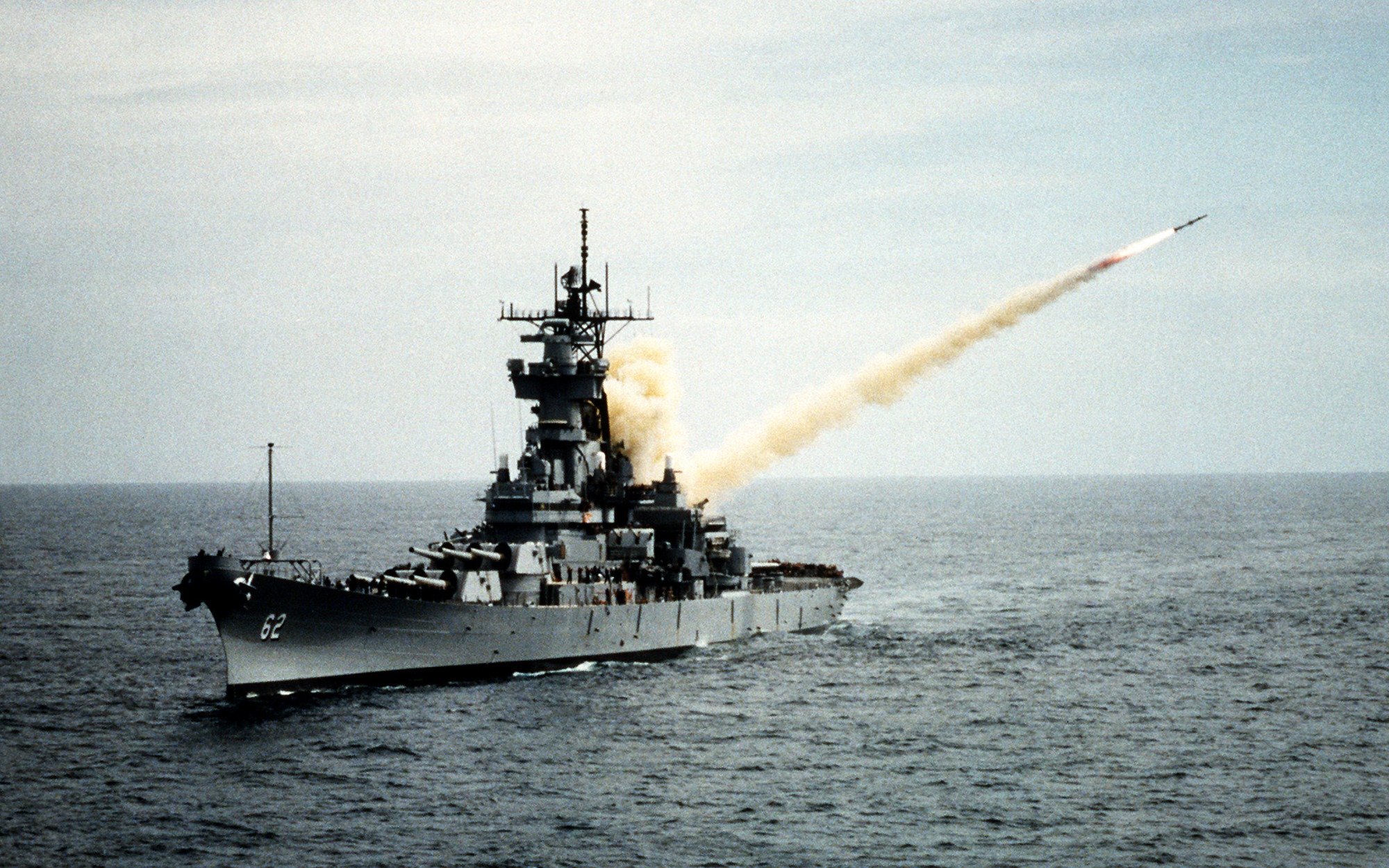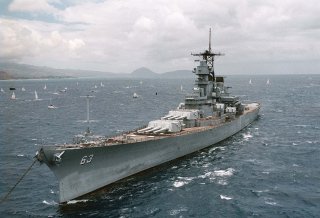Iowa-Class Battleships: The U.S. Military's Secret Weapon During the Korean War
The Iowas certainly delivered a great deal of ordinance to targets on the Korean Peninsula over the course of the war.
Here's What You Need to Know: Only USS Missouri remained operational when the Korean War began, so the other three battleships had to be reactivated and updated.
In the final months of the Second World War, the battleships of the U.S. Navy (USN) ranged across the archipelago of Japan, bombarding industrial, military and logistical targets at will. The Japanese military lacked enough ships, planes and fuel to defend the nation, leaving coastal areas at the mercy of the steel behemoths. Although most of the credit (such that it is) for the destruction of urban Japan belongs to the bombers of the U.S. Army Air Force, the battleships and cruisers of the navy contributed their share.
At the end of the war, most of the USN’s battleships were scrapped, sunk as targets or placed into reserve. When the United States went to war again, earlier than anyone had expected, three battleships of the Iowa class returned to service, joining their sister USS Missouri off the coast of Korea. For three years, these ships would rain terror down upon North Korean and Chinese forces.
Response and Reactivation
The ferocity and efficiency of the North Korean offensive of June 1950 into South Korea took everyone, including the U.S. Navy, by surprise. Nevertheless, local forces quickly responded, including the Oregon City-class heavy cruiser USS Rochester, which used its eight-inch guns to soften beaches at Inchon and elsewhere. USS Missouri, the only U.S. battleship to have remained operational since World War II, arrived in Korean waters on September 19, 1950. In a few weeks she would conduct extensive shore bombardments along the coast of North Korea. Missouri continued to provide fire support after the tide of war turned in November; in December, she conducted bombardments to ensure the survival of U.S. troops retreating from the People’s Liberation Army’s surprise offensive.
Notably, the U.S. Navy decided not to transfer the three heavy cruisers of the Des Moines class, which mostly remained in the Atlantic and the Mediterranean. These cruisers, carrying auto-loading eight-inch guns, could lay waste to a coastal area nearly as effectively as a battleship. However, they were regarded as too important to the mission of deterring the Soviet Union to risk transfer to the Pacific.
Instead, the U.S. government decided to reactivate the three other Iowa class battleships. Iowa, New Jersey and Wisconsin had all entered the reserve fleet before the beginning of the Korean War. All three remained in excellent condition, and required minimal modification in order to return to service. The most significant change came with the replacement of World War II-era floatplanes by helicopters. The navy recommissioned New Jersey in November 1950, Wisconsin in March 1951 and Iowa in August 1951. Several heavy cruisers also conducted tours off of Korea, but the navy declined to reactivate any of the thirteen other battleships in the reserve fleet.
Operations
Each of the four battleships acted as a flagship at one time or another, contributing facilities necessary to the coordination of broader naval warfare efforts. More to the point, however, the battleships used both their sixteen-inch main armament and their five-inch secondary armament to pound Chinese and North Korean positions along the coast. These positions included cave systems, concealed artillery and command posts. As with the end of the Second World War, the battleships also hit strategic and operational targets, including railways, industrial parks and transport centers. These attacks, which could range up to twenty miles inland, periodically disrupted but did not stop Communist efforts to resupply their armies in the field.
Extensive mining reduced the freedom-of-action of U.S. naval forces, to the extent that the battleships only rarely operated against North Korean and Chinese positions along the Yellow Sea. Although Communist aircraft did conduct attacks against major U.S. ships early in the war, UN air and naval superiority made such sorties difficult as the war proceeded. Other than mines, the main danger to the battleships came through coastal artillery, which they regularly sparred against. However, the effectiveness of the USN in bombarding all along the peninsula showed both countries how vulnerable they were to naval attack.
After a refit beginning in March 1951, USS Missouri resumed bombardment and escort duties from October 1952 until March 1953. New Jersey carried out her first shore bombardment in May 1951, and remained in the area until November. She returned for a second tour in April 1953, and remained through the duration of the conflict. USS Wisconsin operated off Korea from November 1951 until April 1952, and USS Iowa contributed short bombardment between April and October 1952.
Reaction
The Iowas certainly delivered a great deal of ordinance to targets on the Korean Peninsula over the course of the war. However, the overall impact of their presence is difficult to assess. Communist forces quickly learned to move critical facilities and troop concentration outside of the range of the battleships’ guns, although the transport network was hard to shift inland. Heavy U.S. bombing of targets across Korea contributed to the general destruction, making it hard to parse out how much the battleships themselves mattered. The smaller, cheaper heavy cruisers could often deliver similar levels of destruction to enemy targets. Still, the very presence of the battleships may have had some degree of psychological effect on Communist and UN forces alike.
Wrap
By 1958, all four Iowas had returned to the reserve fleet. Although they performed their shore bombardment role effectively, but not really any more effectively than the smaller, cheaper heavy cruisers. The manning requirements were significant, however, making them very expensive ships to operate for extended periods of time. The navy would only reactivate one of the four (USS New Jersey) for the Vietnam War, and only in partial service. In the late 1950s and early 1960s, the United States disposed of the remaining thirteen battleships in its inventory.
The Iowas nevertheless survived, and were finally reactivated (and modernized) in the 1980s. The legacy of the Iowas’ performance off Korea lived on in North Korean and Chinese naval doctrine and procurement. Both Pyongyang and Beijing became aware of their dreadful vulnerability to naval attack, and developed coastal defense capabilities intended to dissuade any foe from approaching their waters. China’s People’s Liberation Army Navy has grown past that stage, but the navy of the DPRK continues to concentrate on defensive operations in the littoral.
The Iowas will not, of course, participate in any future conflict on the Korean Peninsula. However, in the event of conflict USN surface ships will undoubtedly contribute significantly to the conflict by means of land attack cruise missiles. Moreover, the navy may yet provide USS Zumwalt and her sisters with the means to provide gunfire support against land targets. In such a case, North Korean coastal installations would become very vulnerable, indeed.


Robert Farley, a frequent contributor to the National Interest, is author of The Battleship Book. He serves as a senior lecturer at the Patterson School of Diplomacy and International Commerce at the University of Kentucky. His work includes military doctrine, national security and maritime affairs. He blogs at Lawyers, Guns and Money, Information Dissemination and the Diplomat.
This article first appeared in 2017 and is being republished due to reader interest.
Image: Reuters.

